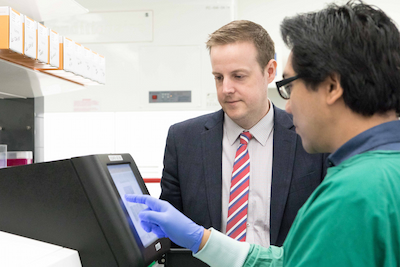Genomic testing for mutations critical for CLL patients pre-treatment
It is essential that people with CLL are genomically tested before they start chemotherapy treatment insists Dr Piers Blombery, who specialises in genomic testing and heads Australia’s largest haematology laboratory.
CLL, which is the most common chronic leukaemia, is, he said, “relatively slow growing in most patients”.

“When you do genomic testing on CLL patients who haven’t had any therapy before, you can divide them into two groups,” said Dr Blombery.
In one group are patients who have high-risk genetic abnormalities, particularly in a gene called p53, and patients who have that abnormality respond very poorly to the standard therapy for CLL, which is the combination chemotherapy, called FCR*.
“Almost no-one who has standard chemotherapy for CLL and who has a p53 mutation goes into deep, complete remission. Any remission these patients get, is very short; around six months,” explained Dr Blombery.
“And considering the therapy itself takes about six months to give, that’s not a lot of time you’ve got from that therapy.”
The second group doesn’t have the p53 mutation or any high-risk genetic lesions.
“When they get chemotherapy, they can stay in remission for more than 10 years.”
“So, you can really classify patients based on quite simple genomic testing, which is basically just looking at p53 and another gene, called IGHV,” Dr Blombery said.
“The problem is that up to 10%, and possibly 20% if you look more sensitively, of patients with CLL will have a p53 or high-risk genetics upfront [when they are initially diagnosed].
“This means if the standard therapy for CLL is given to everyone who comes through the door, then you are doing a disservice to one to two out of 10 patients because they will not respond to chemotherapy adequately, and will have a poor progress-free survival,” said Dr Blombery.
Now that target therapy has really revolutionised the CLL space, Dr Blombery said there are options, both on clinical trials as well as government-funded options, to get people onto non-chemotherapy options, such as ibrutinib (Imbruvica®) and venetoclax (Venclexta®) .
“And these patients with p53 and high-risk genomic lesions do profoundly better on targeted therapies.”
“In fact, we’re moving to a post-chemotherapy era now, in CLL. In five years or so, I’m not sure anyone will be getting chemotherapy for CLL once targeted therapies are all funded upfront,” said Dr Blombery.
“While we’re still in this phase, and certainly over the next few years, I think it’s mandatory to look for the p53 and IGHV mutations by genomically testing patients before FCR treatment is started.”
Dr Blombery said “completely free p53 and IGHV testing” was offered to all newly diagnosed patients who need treatment with CLL in Australia, through the Wilson Centre of Lymphoma Genomics – a philanthropic-funded genomic testing and research organisation based at Peter MacCallum Cancer Centre.
“We’ve been running that for the last three years and we’ve tested 700 CLL patients for the p53 and IGHV mutations,” said Dr Blombery.
“It started off slowly, with not a lot of tests per week but now it’s going full-steam and we’re getting lots of patients being tested.
“I don’t know what the capture rate is and how many are getting tested; it should be all of them, but it’s increasing all the time, which is a move in the right direction.
“We wanted to remove the barrier to testing. This specific test is not funded by the government which is often a barrier to both knowing about the test and having the test done.
“So, with the Wilson Centre for Lymphoma Genomics, David Westerman and myself decided that this was too important to not be offering to patients.
“We thought it would be good use of the philanthropic donation from the Wilson Centre to offer this subsidised testing for as many patients as possible. And, pleasingly, it’s been very popular.
“Clearly, the best approach to funding genomic testing isn’t for individual charities to fund genomic testing because the Federal government needs to be funding testing which has such a significant clinical impact.
“There are moves in place to try and get this funded by the Federal government, but until then, it would be a shame to have to stop, so we will continue on for as long as we can.
“The Wilson Centre for Lymphoma Genetics was started in conjunction with the Snowdome Foundation. Our aim is to provide genomic testing for as many people as possible in the most useful circumstances. And that was an entry level way in which we thought we could provide useful genomic testing,” said Dr Blombery.
Read more about genomic testing in our Expert Series interview with Dr Blombery.
* FCR is a combination of the chemotherapy drugs, fludarabine and cyclophosphamide, and the targeted therapy, rituximab.
Last updated on August 4th, 2021
Developed by the Leukaemia Foundation in consultation with people living with a blood cancer, Leukaemia Foundation support staff, haematology nursing staff and/or Australian clinical haematologists. This content is provided for information purposes only and we urge you to always seek advice from a registered health care professional for diagnosis, treatment and answers to your medical questions, including the suitability of a particular therapy, service, product or treatment in your circumstances. The Leukaemia Foundation shall not bear any liability for any person relying on the materials contained on this website.